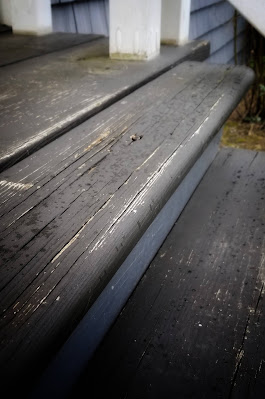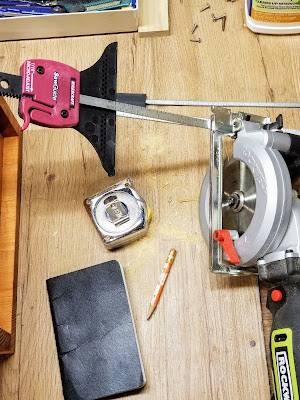One Board in 20 Years - Not Bad!
Back in about 1999 we built a bit of a stoop for the front porch. In the picture above (that's me in the hat) you can see the incredibly steep steps that had been at 173 for lawd knows how long! The stoop was solidly built of pressure treated lumber...

..and a ton of very large screws!
But alas, these nearly 21 years later, the front board on the stoop rotted out...
Rotten on the Inside
At a glance ya' can barely notice, which is really part of the problem. You see, the back door has always been the primary portal in and out, with the front steps used by little more than the mailman. I don't know how I came to notice it, but when I did, this is what I saw...
Made Out Like The Mailman
I mean the center of that board was rotted out the whole length of it, and I think we're lucky, not to mention the mailman, that the board didn't just give way! Off to Lowes I went...and picked up a decking stair tread - pressure treated of course.
The thing is, I only needed about half the depth of the board. So I clamped it on down to
By the way, here's a brief story of the origins of the Workmate. Who knew that the guy who invented it was also the designer of the Lotus Elan:
The Workmate was designed by Ronald Hickman, a South African who left his native country to design cars in England. He was also an avid tinkerer and an amateur builder. While working on a DIY project at home in 1961, he was sawing a piece of lumber on an expensive chair and sawed into its leg. Most people might have purchased a sawhorse at that point. Not Hickman. Hickman set out to design and build a small, portable workbench. The idea he came up with, to solve a relatively simple problem with a complex device, is a classic example of what makes an inventor. Most fail in their attempt, but some succeed, and civilization moves steadily forward. After a lot of experimenting, Hickman arrived at a working design that was part bench, part vise, and part sawhorse. - Roy Berendsohn in Popular Mechanics, June 2015
Turns out the guide was a little awkward but it worked really well. With a little practice it should be a handy little helper. It's pretty cool because it comes with a few different size bars so it can work on a bunch of different saws. It has a built-in gauge for adjusting the distance from the blade, but quite frankly it's probably easier to adjust that distance at the hex screw where the bars joins with the saw (or drill) base. It was definitely worth the $10.
I didn't get any shots of the old, rotted board as it was being removed, but there really wasn't much left of it, and it gave up the ghost without much fight. Then the new piece went in, hopefully there to remain for another 20 years! I'll give it a few weeks to dry then it'll get stained with the annual stoop step staining (try saying that 3 times fast!).
Be safe!











